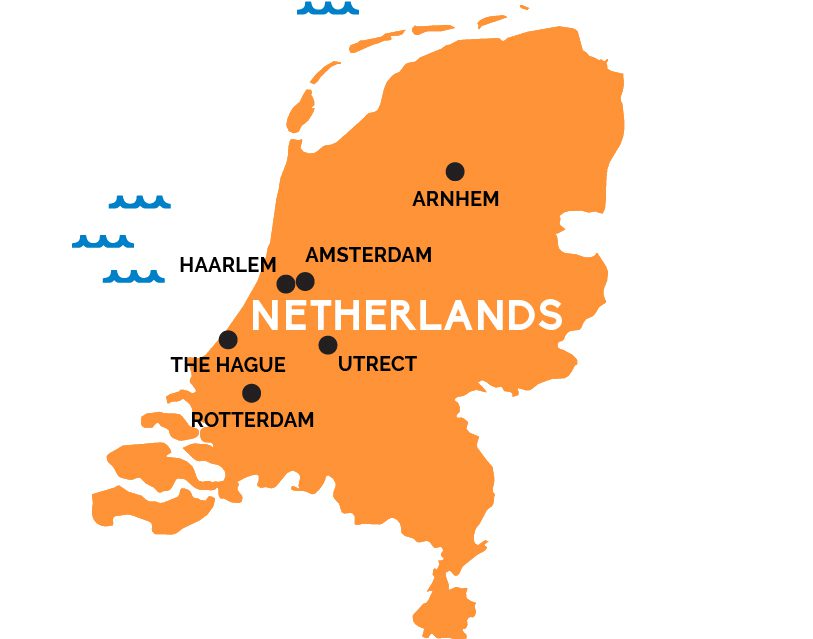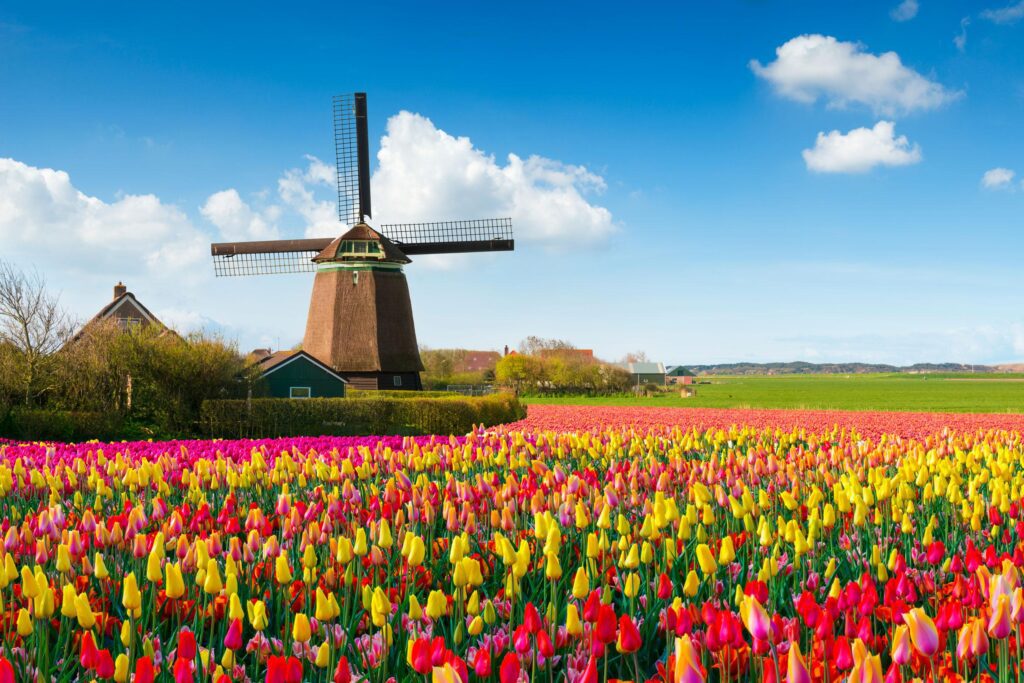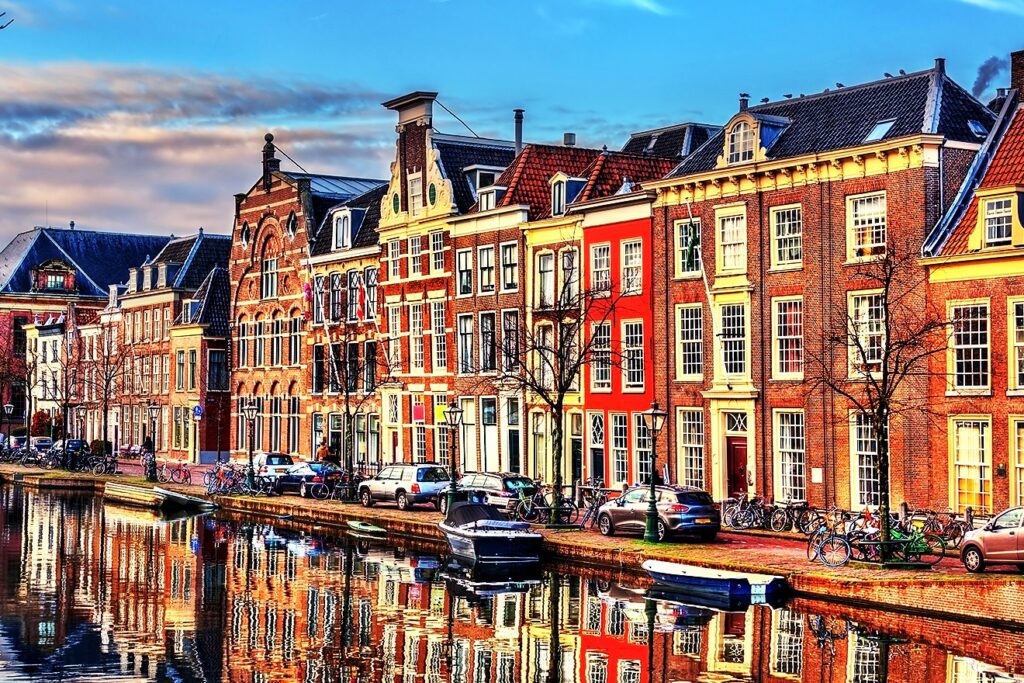Academic Country Snapshot - Netherlands
Below is a list and summary of additional academic resources and articles to expand your knowledge on Netherlands before your trip abroad!
Have any questions or want more information? Call us at (480) 874-0100 or Contact us.
History
The Netherlands evolved from early Roman times into a nation defined by resilience, economic power, and cultural tolerance. Starting as a collection of provinces, it unified into a powerful republic in the 16th century, thriving in the Dutch Golden Age through trade, science, and art. Despite challenges like French occupation and WWII, the Netherlands transitioned to a modern constitutional monarchy. With a legacy of notable artists, colonial influence, and the Dutch East India Company, the country is celebrated today for its liberal policies, quality of life, and global significance.

The Eighty Years' War
The Eighty Years’ War (1568–1648) was a long struggle for Dutch independence from Spanish rule, fueled by religious, economic, and political tensions. Protestant provinces, opposing Catholic Spain, formed the Union of Utrecht, a pact that marked the start of the Dutch Republic. Key events included major battles, naval conflicts, and shifts in alliances, with leaders like William of Orange playing pivotal roles. The war concluded with the Peace of Westphalia in 1648, recognizing Dutch independence and establishing the Netherlands as a significant European power.
European Union
The Netherlands values its active role in the European Union, advocating for cooperation on security, climate action, and migration while supporting a strong single market. It works closely with other member states on EU reforms to ensure effective governance and aims to address global challenges like sustainability and economic stability. Balancing national and EU interests, the Netherlands emphasizes fair contributions and decision-making that respects member sovereignty.


Economy
Overview
The Dutch economy experienced slowed growth in 2023 due to inflation and weak exports. Projected growth for 2024 is modest at 0.8%, supported by wage increases and public investment, while business investment may stay weak. By 2025, growth could reach 1.5% as trade and investment conditions improve. Inflation is set to decline gradually, and the government deficit is expected to increase slightly due to rising public spending. Unemployment may edge up, but the labor market remains tight.
The Netherlands uses the euro (€) as its official currency, adopted in 2002 for physical transactions after an initial electronic introduction in 1999. Before this, the Dutch guilder was used for over 300 years. The guilder is still used in parts of the Kingdom of the Netherlands, like Sint Maarten and Curaçao. While guilder coins were exchangeable until 2007, banknotes remain valid for exchange until 2032.
Business and Trade
The Netherlands, with its advanced infrastructure and strategic location, ranks as a global business hub and one of the world’s top trading nations. With a highly competitive economy, the Netherlands excels in logistics, innovation, and international trade. It’s a key market for U.S. exports, offering an English-fluent, affluent, and U.S.-friendly population. Economic growth in recent years has outpaced nearby countries, primarily due to increased household consumption and employment.
Geography
Nature in Netherlandes
The Netherlands is a low-lying country with diverse ecosystems, covering about 41,543 km². It has a rich biodiversity, including numerous species of flora and fauna. The country has designated several protected areas, including Natura 2000 sites, to preserve its unique habitats. Key challenges for biodiversity include urbanization, agriculture, and climate change, which threaten natural environments. Conservation efforts are ongoing to enhance ecological resilience and promote sustainable land use practices.
The Netherlands boasts breathtaking nature destinations, including the Wadden Sea, famous for its tidal flats and rich wildlife. Iconic tulip fields bloom in spring, while national parks like Hoge Veluwe and Zuid-Kennemerland offer diverse ecosystems for outdoor activities like hiking and cycling. Coastal areas and wetlands provide unique habitats, contributing to the country’s impressive biodiversity. Conservation efforts are essential for preserving these natural treasures.
Urban Planning
Urban planning in The Hague’s city center, particularly around Frederik Hendrik’s era, reflects the influence of political and social dynamics. The development choices in this area highlight how urban planning serves both governance and public needs, mirroring societal priorities and ideals. Decisions regarding public spaces and structural layouts underscore the interaction between authority and community, shaping the cityscape in ways that integrate policy with the lived environment..
Customs & Traditions
Art and Festivals
The Netherlands has a rich cultural life influenced by its history and geographic location. It boasts a vibrant arts scene, particularly in painting, with notable figures like Rembrandt and Van Gogh. Traditional music includes folk styles, and modern genres thrive in festivals. The Dutch celebrate various festivals, including King’s Day and Carnival. Culinary diversity reflects its multicultural society, with a mix of traditional dishes and international cuisine. Museums, theaters, and a commitment to cultural preservation enrich the nation’s identity.
Culture in the Netherlands is full of unique and fun celebrations. Key Dutch traditions include Sinterklaas, celebrated on December 5 with gift-giving and poems, and King’s Day on April 27, marked by wearing orange and street festivities. Liberation Day on May 5 commemorates World War II’s end. National foods like herring, bitterballen, and oliebollen are widely enjoyed, particularly on holidays. Other customs involve ice skating during winter, carnival celebrations in February, and the Elfstedentocht, a famous ice-skating race, when conditions permit.
Food
Traditional Dutch foods include stroopwafels, thin caramel-filled waffles, and poffertjes, mini fluffy pancakes often served with butter and powdered sugar. Bitterballen, crispy meat-based snacks, are popular pub treats, and haring (herring) is traditionally eaten raw with onions and pickles. For a hearty meal, try stamppot, mashed potatoes with vegetables, or erwtensoep, a thick pea soup. Gouda and Edam cheese are Dutch staples, and patat, a thicker fry, often comes with unique sauces like mayonnaise-based frietsaus.
Multicultularism
The Netherlands has a multicultural society with a majority Dutch population and significant immigrant communities, including Turkish, Moroccan, and Surinamese. Dutch society values equality, and many people speak English and German in addition to Dutch. The country’s commitment to tolerance and inclusivity has shaped its social policies, though immigrant communities sometimes face discrimination. Ethnic minorities often reside in urban centers, enriching cultural diversity. There is also a notable Frisian community in the northern Netherlands, which has its own language and customs.
Dress & Clothing
Modern Fashion
The Dutch fashion market is characterized by sustainability, innovation, and a strong sense of personal style. Amsterdam serves as a key fashion hub, with numerous events like Amsterdam Fashion Week promoting both established and emerging brands. Dutch consumers favor quality, ethical production, and practicality in their fashion choices, with a focus on eco-friendly and durable clothing. International brands also see the Netherlands as a strategic entry point for broader European markets due to its location and advanced logistics network.
Traditional Clothing
Traditional Dutch clothing is practical and regionally diverse, with distinct styles in each province. The iconic Dutch look includes items like the white lace cap and wooden clogs (klompen), which were historically worn by farmers and fishers. Regional variations range from the colorful, embroidered skirts and aprons of Volendam to the ornate bonnets of Zeeland. While rarely worn daily, traditional attire is preserved in cultural festivals, museums, and certain communities, symbolizing Dutch heritage and regional pride.
Dressing for the Weather
Amsterdam’s weather varies greatly, so layers are key. Spring and fall can be cool and rainy, so bring a jacket and waterproof shoes. In summer, light clothing with a sweater for cooler evenings works well, while winter calls for a warm coat, gloves, and a hat. Comfortable shoes are a must year-round, especially for walking on cobblestones and cycling. An umbrella or raincoat helps manage the frequent rain, and neutral colors help blend with the city’s stylish, casual vibe. Don’t let the wrong clothes ruin your time in the Netherlands. Pack the best clothing and shoes according to the time of year and probable weather conditions.
Special Considerations
Dutch Customs and Communication Style
Dutch customs emphasize politeness, modesty, and direct communication. People typically greet each other with handshakes or, among friends, three cheek kisses. Punctuality is valued, and it’s customary to make appointments in advance. In social settings, everyone contributes their share when dining out. The Dutch are known for their openness about opinions, but they avoid discussing personal finances and religion. Modesty in clothing is common, and personal space is respected. Gift-giving is simple and thoughtful, often with flowers or chocolates for hosts. Discover helpful do’s and don’ts as you prepare to travel to the netherlands.
LGBTQ+ Protections
The Netherlands supports LGBTQ+ rights with legal protections and widespread social acceptance. Same-sex marriage has been legal since 2001, and adoption rights and gender recognition are accessible. Anti-discrimination laws are in place to protect against bias based on sexual orientation and gender identity, contributing to an inclusive environment. However, infrequent reports of homophobia and discrimination persist in certain areas, indicating ongoing work towards equality.
Safety
It is important to be aware and informed of possible complications during your time in the Netherlands. Like many countries, there may be petty theft and scams in place that target tourists especially. Petty crime like pickpocketing is common in busy areas and on public transport in the Netherlands, so keep an eye on belongings. In addition, it is important to be prepared and aware of bikers and take care when cycling due to heavy bike traffic and specific road rules. Overall, the Netherlands is considered a safe country to live in and visit as a tourist. Be sure to stay aware of your surroundings and don’t be afraid to question a situation if something feels off.
Essential Dutch Phrases
Learning a few basic Dutch phrases helps travelers connect with locals and navigate common situations with ease, from greetings and polite expressions to ordering food and asking for directions. Understanding some Dutch enhances experiences at restaurants, shops, and public transport. While many Dutch people speak English, they often appreciate visitors making an effort in Dutch, which can create a friendlier atmosphere. Emphasizing key phrases can lead to more rewarding interactions and smooth day-to-day travel experiences in the Netherlands. Discover some helpful examples for everyday use as well as key phrases in case of emergency.
Mastering The Dutch Language
For those interested in learning more than a little bit of Dutch, mastering Dutch involves a mix of practical approaches, like practicing daily phrases, listening to Dutch media, and using language apps for vocabulary building. Engaging with native speakers through language exchanges, or even classes, can boost confidence and comprehension. In addition, learning the rules of pronunciation will help immensely. Adopting immersion techniques—like setting device languages to Dutch or watching Dutch TV—reinforces learning. Patience and consistency are key, as Dutch can be challenging but rewarding, especially when paired with a positive attitude toward making mistakes and learning from them.
English Proficiency in Netherlands
As you travel the Netherlands, you may discover that their people often have no issues communicating in English. The Dutch are widely proficient in English, thanks to early language education, the similarity between Dutch and English, and exposure to English media. Most Dutch people learn English from a young age, making them confident speakers. Cultural openness to international media, combined with a practical attitude toward English as a global language, also supports high proficiency. As a result, visitors often find communication easy, especially in cities, though learning a few Dutch phrases can still be helpful and appreciated.
U.S. Embassy & Consulate Resources
Understanding the differences between an Embassy, a Consulate, and a Mission
Check out this video from the National Museum of American Diplomacy explaining the difference between each organization and how they function together to protect US citizens traveling abroad. LINK


U.S. Embassies & Consulates in Netherlands
LINK to list of U.S. Embassies and Consulates in the Netherlands
Netherlands Trivia
The Netherlands is renowned for its cycling culture, with bikes outnumbering residents. This transformation began in the 1970s as the Dutch prioritized safety and sustainable urban design, creating dedicated bike lanes and limiting car use in cities. Urban planning initiatives make cycling a safe, efficient, and preferred mode of transport, with benefits for public health, the environment, and urban life. Today, cycling is a core part of Dutch identity, supported by extensive infrastructure and government commitment to green, accessible transportation.
The Dutch have become the tallest people in the world, with an average male height of about 6 feet. Researchers attribute this to a mix of genetic factors, environmental influences, and high consumption of dairy products. Evolutionary adaptation might also play a role, as taller individuals in the Netherlands historically had more children, passing on height-related traits. This unique combination of diet, natural selection, and genetics has helped shape the Dutch population’s notable stature.
Amsterdam’s canals, recognized as a UNESCO World Heritage site, are a hallmark of the city’s charm and history. Built in the 17th century to support trade and manage water levels, the canals create a scenic, concentric layout that reflects Amsterdam’s engineering skill. The three main canals—Herengracht, Prinsengracht, and Keizersgracht—span the city, offering stunning views, houseboats, and iconic canal houses. Today, they’re enjoyed by locals and tourists alike, who explore them via boat tours, bike rides, or leisurely walks along their scenic paths.

